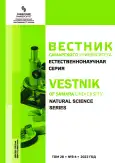Том 28, № 3-4 (2022)
Математика
Разрешимость обратной коэффициентной задачи с интегральным переопределением для одномерного параболического уравнения
Аннотация
Исследуется разрешимость коэффициентной обратной задачи с нелокальными краевыми условиями и интегральным условием переопределения для одномерного параболического уравнения. Обоснование существования единственного решения базируется на полученных в работе априорных оценках и результатах о разрешимости прямой нелокальной задачи для изучаемого уравнения.
 7-17
7-17


О характеризации группы числами классов сопряженных элементов
Аннотация
Обозначим через число классов сопряженных элементов, на которые распределяются в группе элементы порядка n. В статье рассматривается проблема распознавания конечной группы по множеству ncl(G), состоящему из чисел Доказывается, что абелевы группы распознаются по множеству ncl(G) при известном порядке группы. Описываются также некоторые другие типы распознаваемых групп. Приведены примеры неизоморфных групп, для которых множества ncl(G) совпадают. Доказано несколько теорем о распознавании группы по частичным условиям на
 18-25
18-25


О системах векторов и подпространств конечномерного пространства, восстанавливающих вектор-сигнал
Аннотация
Предметом рассмотрения данной статьи являются системы векторов, допускающие восстановление неизвестного вектор-сигнала по модулям измерений, и подпространства, восстанавливающие сигнал по нормам проекторов на них. Проанализирована взаимосвязь свойств восстановления по модулям измерений и восстановления по нормам проекций со свойствами альтернативной полноты в евклидовом и унитарном пространствах. Рассмотрена теорема о рангах одного линейного оператора, которая может рассматриваться как еще один критерий возможности восстанавливать вектор-сигнал. Доказана эквивалентность свойства альтернативной полноты и утверждения упомянутой теоремы о рангах для евклидова пространства. Показано, что теорему о рангах в вещественном случае можно распространить на системы подпространств.
Рассмотрены вопросы о минимальном количестве векторов, допускающих восстановление по модулям измерений. Приведены имеющиеся на данный момент результаты, которые обобщены в виде таблицы для пространств размерности 10 и ниже. Также кратко приведены известные результаты к вопросу о минимальном количестве подпространств, допускающих восстановление по нормам проекций.
 26-31
26-31


Редукция задачи оптимального слежения при наличии шумов
Аннотация
В статье метод декомпозиции, основанный на применении теории быстрых и медленных интегральных многообразий, применяется для анализа задачи оптимального слежения. Рассматривается сингулярно возмущенная задача оптимального слежения с заданной эталонной траекторией в случае неполной информации о векторе состояния при наличии случайных внешних возмущений.
 32-39
32-39


Механика
Общая теория ортотропных оболочек. Часть II
Аннотация
Современное машиностроение порой ставит задачи по расчету тонкостенных конструкций со взаимоисключающими свойствами: с одной стороны, исследуемые конструкции должны сочетать в себе высокую прочность и надежность, а с другой — легкость и экономичность. Для обеспечения вышеперечисленных свойств представляется вполне оправданным использование в конструкциях ортотропных материалов и пластиков.
Во второй части статьи на примерах продемонстрированы дальнейшие возможности методики комплексного представления уравнений общей теории ортотропных оболочек (для изотропных оболочек сделано В.В. Новожиловым), которые позволили существенно сократить число неизвестных и порядок системы дифференциальных уравнений. Особенностью предложенной методики для ортотропных оболочек является появление комплексно-сопряженных неизвестных функций, которые в случае осесимметричной деформации обращаются в нуль, а в других случаях влиянием комплексно-сопряженной функции можно пренебречь.
Проверка правильности предложенной методики была продемонстрирована на пологой ортотропной сферической оболочке вращения под действием кольцевой нагрузки в условиях различного преобладания жесткости армирования волокон. В предельном случае были получены результаты и для изотропной оболочки.
 40-52
40-52


Отсчетная форма тел с конечными несовместными деформациями
Аннотация
В статье развиваются дифференциально-геометрические методы моделирования конечных несовместных деформаций гиперупругих твердых тел. Несовместность деформаций может быть вызвана, к примеру, неоднородными температурными полями и распределенными дефектами. Как следствие, возникают внутренние напряжения и искажение геометрической формы тела. Эти факторы определяют критические параметры современных высокоточных технологий, в частности, в технологиях аддитивного изготовления. В этой связи развитие методов их количественного описания является актуальной проблемой современной механики деформируемого твердого тела.
Применение методов дифференциальной геометрии основано на представлении тела в виде гладкого многообразия, снабженного метрикой и неевклидовой связностью. Такой подход позволяет интерпретировать тело как глобальную, свободную от напряжений форму и сформулировать физический отклик и материальные уравнения баланса относительно этой формы. В рамках геометрического метода деформации характеризуются вложениями неевклидовой формы в физическое пространство, которое по-прежнему считается евклидовым. Меры несовместности отождествляются с инвариантами аффинной связности — кручением, кривизной и неметричностью, а сама связность определяется типом физического процесса.
 53-87
53-87


К вопросу экспериментального и численного определения коэффициентов многопараметрического ряда М. Уильямса
Аннотация
В статье определяются поля напряжений вблизи кончиков математических разрезов в изотропной линейно-упругой пластине с двумя горизонтальными коллинеарными трещинами, лежащими на одной прямой, разной длины с помощью двух подходов – экспериментального, основывающегося на методе цифровой фотомеханики, и численного, опирающегося на вычислениях методом конечных элементов. Для представления поля напряжений у кончика разреза применяется многочленный ряд Уильямса — каноническое представление поля у вершины математического разреза двумерной задачи теории упругости для изотропных сред. Главная идея исследования заключается в учете регулярных (неособых) слагаемых ряда и анализе их воздействия на целостное описание поля напряжений в непосредственной близости вершины разреза. В работе были сохранены и определены первые пятнадцать коэффициентов ряда Макса Уильямса в соответствии с экспериментальными картинами изохроматических полос и конечно-элементным моделированием. Для извлечения коэффициентов ряда М. Уильямса использовался переопределенный метод, предназначенный для решения систем алгебраических уравнений, число которых существенно больше неизвестных – амплитудных множителей. Продемонстрировано влияние неособых слагаемых ряда Уильямса при обработке экспериментальной картины интерференционных полос. Установлено, что сохранение слагаемых высокого порядка малости позволяет расширить область, примыкающую к кончику трещины, из которой можно выбирать экспериментальные точки. Конечно-элементное исследование проведено в системе инженерного анализа SIMULIA Abaqus, в которой воспроизведены экспериментальные образцы, испытанные в натурном эксперименте. Показано, что результаты, полученные двумя методами, хорошо согласуются друг с другом.
 88-104
88-104


Последовательность разрушения слоев двуслойной балки при трехточечном нагружении
Аннотация
В статье рассматривается хрупкое разрушение двухслойной балки в условиях трехточечного нагружения в зависимости от рассматриваемых параметров — различных пропорций толщин, модулей Юнга и прочностей обоих слоев. На основании уравнений равновесия сил и моментов выводятся зависимости положения нейтральной оси балки, ее кривизны и определяются области параметров, при которых разрушение начинается ранее в слое, к которому прилагается нагрузка, чем во внешнем противоположном нагрузке слое.
 105-110
105-110










